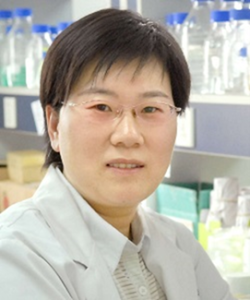Student Created Scientist Spotlights – Shining a Light to Encourage Diversity in STEM
LiJun Bi – Mycobacterium tuberculosis bacteria
Mona (Xiao Ming) Huang and Zoë Soon

LiJun Bi
PhD, Professor of Institute of Biophysics, Chinese Academy of Sciences
Mycobacterium tuberculosis bacteria (MTB) is the cunning culprit behind tuberculosis, a respiratory infectious disease that has been threatening people as well as wild and domestic animals worldwide since the beginning of human history (at least 9,000 years according to anthropologists (CDC). The Bacille Calmette-Guérin (BCG) vaccine was the first impactful weapon that humans have against MTB. While it has been observed to successfully lower mortality rates due to tuberculosis worldwide, there has been mixed evidence regarding its efficacy (“Weekly epidemiological record”, 2018). In general, various studies have agreed that the BCG vaccine has an efficacy of at least 50%, but each came to different conclusions regarding its true efficacy (Vaudry, 2003). It is also worth noting that the vaccine has higher efficacy in children than adults, which presents a problem for adults who may work in high-risk fields, such as healthcare (“Weekly epidemiological record”, 2018). Multidrug-resistant tuberculosis also increases treatment difficulties, and further prolongs treatment time and expenses for patients (“Tuberculosis”, 2021). Both drug resistance and unknown vaccine efficacy poses barriers to tuberculosis treatment. As one of the leaders in research in drug resistance and vaccine against MTB, Dr. Lijun Bi at the Chinese Academy of Science (CAS) hopes to change that reality.
By utilizing bioinformatics tools, Dr. Bi’s work led to the construction of a purified proteome microarray, which is essentially a library of most proteins that are expressed in MTB. (Deng et al., 2014) This tool could accelerate drug discovery by providing readily accessible and purified MTB proteins, which allows researchers to screen and analyze these proteins for drug and vaccine targets quickly. Recently, she is involved in identification of three potential vaccine targets through systematic analysis of MTB proteins (Wang et al., 2021). On a different frontier, Dr. Bi has investigated mutations responsible for drug resistance in MTB using whole genome sequencing approach (CRyPTIC Consortium and the 100,000 Genomes Project et al., 2018). These results could potentially help clinicians better optimize their treatment plan based on drug resistance and improve patient outcome over time.
Outside of her role as a principal investigator of CAS, Dr. Bi also thrives as an entrepreneur by running her own biotechnology company. Her research has translated into tools that allow clinicians to rapidly screen for MTB infection in patients, and they have been implemented in many major hospitals in China (“TB Healthcare”, n.d.). To date, she has won multiple awards in the Chinese scientific community for her contributions in tuberculosis research, including the China Anti-Tuberculosis Association Excellence in Science and Technology Award (“Faculty”, n.d.). Hopefully, Dr. Bi’s research can help bring the medical community one step closer to elimination of tuberculosis.
References
- CRyPTIC Consortium and the 100,000 Genomes Project, Allix-Béguec, C., Arandjelovic, I., Bi, L., Beckert, P., Bonnet, M., Bradley, P., Cabibbe, A. M., Cancino-Muñoz, I., Caulfield, M. J., Chaiprasert, A., Cirillo, D. M., Clifton, D. A., Comas, I., Crook, D. W., De Filippo, M. R., de Neeling, H., Diel, R., Drobniewski, F. A., Faksri, K., … Zhu, B. (2018). Prediction of Susceptibility to First-Line Tuberculosis Drugs by DNA Sequencing. The New England journal of medicine, 379(15), 1403–1415. https://doi.org/10.1056/NEJMoa1800474
- Deng, J., Bi, L., Zhou, L., Guo, S. J., Fleming, J., Jiang, H. W., Zhou, Y., Gu, J., Zhong, Q., Wang, Z. X., Liu, Z., Deng, R. P., Gao, J., Chen, T., Li, W., Wang, J. F., Wang, X., Li, H., Ge, F., Zhu, G., … Zhang, X. E. (2014). Mycobacterium tuberculosis proteome microarray for global studies of protein function and immunogenicity. Cell reports, 9(6), 2317–2329. https://doi.org/10.1016/j.celrep.2014.11.023
- Faculty—-Institute of biophysics of chinese academy of sciences. (n.d.). Retrieved August 19, 2022, from http://english.ibp.cas.cn/faculty/index_18316.html?json=http%3A%2F%2Fwww.ibp.cas.cn%2Fsourcedb_ibp_cas%2Fcn%2Fibpexport%2FEN_zgkxyhsswxzdsys%2F202005%2Ft20200519_5583025.json#
- Tuberculosis (TB). World Health Organization. Retrieved August 19, 2022, from https://www.who.int/news-room/fact-sheets/detail/tuberculosis
- Vaudry W. (2003). “To BCG or not to BCG, that is the question!”. The challenge of BCG vaccination: Why can’t we get it right?. Paediatrics & child health, 8(3), 141–144. https://doi.org/10.1093/pch/8.3.141
- Wang, Y., Li, Z., Wu, S., Fleming, J., Li, C., Zhu, G., Chen, B., Ren, B., Wang, X., Du, B., Li, P., Hu, P., Yang, J., Liu, Y., Zhou, C., Zhang, X. E., Bi, L., Zhang, H., Yang, J., & Zhang, Z. (2021). Systematic Evaluation of Mycobacterium tuberculosis Proteins for Antigenic Properties Identifies Rv1485 and Rv1705c as Potential Protective Subunit Vaccine Candidates. Infection and immunity, 89(3), e00585-20. https://doi.org/10.1128/IAI.00585-20
- Weekly epidemiological record. (2022, August 19). Weekly Epidemiological Record (WER). Retrieved from http://www.who.int/wer.

